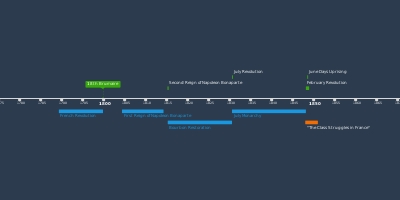February Revolution (22 feb 1848 año – 2 dic 1848 año)
Descripción:
"The potato blight and the crop failures of 1845 and 1846 aggravated the general ferment among the people. In France, as on the rest of the Continent, the rising prices of 1848 provoked bloody conflicts. While the people struggled for basic necessities, the financial aristocracy indulged in shameless orgies. In Buzançais starving rebels were executed, in Paris surfeited escrocs were snatched out of the hands of the courts by the royal family!
The second great economic event to accelerate the outbreak of the revolution was a general commercial and industrial crisis in England. Heralded as early as autumn 1845 by the wholesale ruin of speculators in railway shares, delayed during 1846 by a series of circumstantial factors such as the imminent abolition of the corn duties, this crisis finally broke out in autumn 1847 with the bankruptcies of the great London wholesale grocers. They were rapidly followed by the insolvencies of the land banks and the closure of factories in the English industrial districts. The after-effects of this crisis on the Continent were not yet at an end when the February revolution broke out.
The devastation of commerce and industry resulting from the economic epidemic made the rule of the financial aristocracy even more intolerable. Throughout France the bourgeois opposition campaigned for electoral reform with a series of banquets, aiming to win a parliamentary majority and overthrow the ministry of the “ate the outbreak of the revolution was a general commercial and industrial crisis in England. Heralded as early as autumn 1845 by the wholesale ruin of speculators in railway shares, delayed during 1846 by a series of circumstantial factors such as the imminent abolition of the corn duties, this crisis finally broke out in autumn 1847 with the bankruptcies of the great London wholesale grocers. They were rapidly followed by the insolvencies of the land banks and the closure of factories in the English industrial districts. The after-effects of this crisis on the Continent were not yet at an end when the February revolution broke out.
The devastation of commerce and industry resulting from the economic epidemic made the rule of the financial aristocracy even more intolerable. Throughout France the bourgeois opposition campaigned for electoral reform with a series of banquets, aiming to win a parliamentary majority and overthrow the ministry of the Bourse. In Paris the industrial crisis had the particular effect of forcing a huge number of manufacturers and wholesale merchants, who could not conduct business with foreign markets under the existing circumstances, onto the domestic market. They set up large establishments, whose competition ruined masses of épiciers and boutiquiers. Hence the innumerable bankruptcies among this section of the Paris bourgeoisie; hence their revolutionary behaviour in February. It is well known how Guizot and the Chambers replied to the proposed reforms with an unmistakable challenge, how Louis Philippe decided too late to form a government under Barrot, how it came to hand-to-hand fighting between the people and the army, how the army was disarmed by the passive behaviour of the National Guard, and how the July monarchy was forced to make way for a provisional government.”
p. 374-5
Añadido al timeline:

Timeline for The Class Struggle in France & the 18th Brumaire of Louis Bonaparte
fecha:
